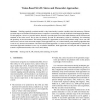40 search results - page 7 / 8 » Mobile Robot Self-Localization without Explicit Landmarks |
ICRA
2005
IEEE
14 years 3 months ago
2005
IEEE
Building cooperatively 3-D maps of unknown environments is one of the application fields of multi-robot systems. This article addressesthatproblemthroughaprobabilisticapproachbas...
IROS
2008
IEEE
14 years 4 months ago
2008
IEEE
—This paper presents an alternative formulation for the Bayesian feature-based simultaneous localisation and mapping (SLAM) problem, using a random finite set approach. For a fe...
AAAI
1992
13 years 11 months ago
1992
The goal in automatic programming is to get a computer to perform a task by telling it what needs to be done, rather than by explicitly programming it. This paper considers the ta...
ICRA
2006
IEEE
14 years 3 months ago
2006
IEEE
— In this paper we consider a single hand-held camera performing SLAM at video rate with generic 6DOF motion. The aim is to optimise both the localisation of the sensor and build...
IJCV
2007
13 years 9 months ago
2007
Building a spatially consistent model is a key functionality to endow a mobile robot with autonomy. Without an initial map or an absolute localization means, it requires to concurr...

